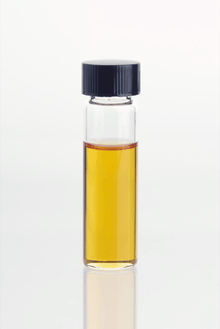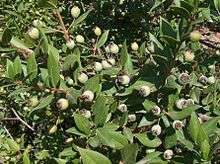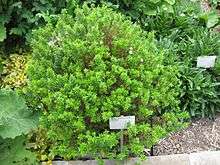Myrtus
| Myrtus Myrtle | |
|---|---|
 | |
| Myrtus communis | |
 | |
| Myrtle (M. communis)[1] | |
| Scientific classification | |
| Kingdom: | Plantae |
| (unranked): | Angiosperms |
| (unranked): | Eudicots |
| (unranked): | Rosids |
| Order: | Myrtales |
| Family: | Myrtaceae |
| Genus: | Myrtus L. |
| Type species | |
| Myrtus communis L.[2][3] | |
| Species | |
|
Myrtus communis L. | |
| Synonyms[4] | |
|
Myrthus Scop. | |

Myrtus, with the common name myrtle, is a genus of flowering plants in the family Myrtaceae, described by Linnaeus in 1753.[3]
Over 600 names have been proposed in the genus, but nearly all have either been moved to other genera or been regarded as synonyms. The Myrtus genus has two species recognised today:[4]
- Myrtus communis — Common myrtle; native to the Mediterranean region in southern Europe.
- Myrtus nivellei — Saharan myrtle; native to North Africa.
Description
Common myrtle
Myrtus communis, the common myrtle or true myrtle, is native across the northern Mediterranean region (especially in the islands of Sardinia and Corsica, where it is locally known by the name of murta).[5]
The plant is an evergreen shrub or small tree, growing to 5 metres (16 ft) tall. The leaf is entire, 3–5 cm long, with a fragrant essential oil.
The star-like flower has five petals and sepals, and numerous stamens. Petals usually are white. The flower is pollinated by insects.
The fruit is a round berry containing several seeds, most commonly blue-black in colour. A variety with yellow-amber berries is also present. The seeds are dispersed by birds that eat the berries.
Saharan myrtle
Myrtus nivellei, the Saharan myrtle, (Tuareg language: tefeltest), is endemic to the mountains of the central Sahara Desert.[6] It is found in a restricted range in the Tassili n'Ajjer Mountains in southern Algeria, and the Tibesti Mountains in northern Chad.
It occurs in small areas of sparse relict woodland at montaine elevations above the central Saharan desert plains.[6]
It is a traditional medicinal plant for the Tuareg people.[6]
Several botanists do not consider Myrtus nivellei sufficiently distinct to be treated as a separate species. It is listed as an endangered species.
Uses
Cultivation
Myrtus communis, the Common Myrtle, is widely cultivated as an ornamental plant for use as a shrub in gardens and parks. It is often used as a hedge plant, with its small leaves shearing cleanly.
When trimmed less frequently, it has numerous flowers in late summer. It requires a long hot summer to produce its flowers, and protection from winter frosts.
The species and the subspecies M. communis subsp. tarentina have gained the Royal Horticultural Society's Award of Garden Merit.[7][8]
Culinary
Myrtus communis, the Common Myrtle, is used in the islands of Sardinia and Corsica to produce an aromatic liqueur called Mirto by macerating it in alcohol. Mirto is one of the most typical drinks of Sardinia and comes in two varieties: mirto rosso (red) produced by macerating the berries, and mirto bianco (white) produced from the less common yellow berries and sometimes the leaves.[9]
Many Mediterranean pork dishes include Myrtle berries - and roasted baby pig is often stuffed with myrtle sprigs in the belly cavity, to impart an aromatic flavour to the meat.
The berries, whole or ground, have been used as a pepper substitute.[10] They contribute to the distinctive flavor of Mortadella sausage and the related American Bologna sausage.
In Calabria, dried figs are threaded through a Mirto branch and then baked. The figs acquire a pleasant taste from the essential oils of the herb. They are then baked and enjoyed through the winter months.
Medicinal

Myrtle occupies a prominent place in the writings of Hippocrates, Pliny, Dioscorides, Galen, and the Arabian writers.[11]
In several countries, particularly in Europe and China, there has been a tradition for prescribing this substance for sinus infections. A systematic review of herbal medicines used for the treatment of rhinosinusitis concluded that the evidence that any herbal medicines are beneficial in the treatment of rhinosinusitis is limited, and that for Myrtus there is insufficient data to verify the significance of clinical results.[12]
In myth and ritual

- Classical
In Greek mythology and ritual the myrtle was sacred to the goddesses Aphrodite[13] and also Demeter: Artemidorus asserts that in interpreting dreams “a myrtle garland signifies the same as an olive garland, except that it is especially auspicious for farmers because of Demeter and for women because of Aphrodite. For the plant is sacred to both goddesses.”[14] Pausanias explains that one of the Graces in the sanctuary at Elis holds a myrtle branch because “the rose and the myrtle are sacred to Aphrodite and connected with the story of Adonis, while the Graces are of all deities the nearest related to Aphrodite.” Myrtle is the garland of Iacchus, according to Aristophanes,[15] and of the victors at the Theban Iolaea, held in honour of the Theban hero Iolaus.[16]
In Rome, Virgil explains that “the poplar is most dear to Alcides, the vine to Bacchus, the myrtle to lovely Venus, and his own laurel to Phoebus.”[17] At the Veneralia, women bathed wearing crowns woven of myrtle branches, and myrtle was used in wedding rituals. In the Aeneid, myrtle marks the grave of the murdered Polydorus in Thrace. Aeneus' attempts to uproot the shrub cause the ground to bleed, and the voice of his dead brother warns him to leave. The spears which impaled Polydorus have been magically transformed into the myrtle which marks his grave.[18]
In the Mediterranean, myrtle was symbolic of love and immortality. In their culture the plant was used extensively and was considered an essential plant.
- Jewish
In Jewish liturgy, the myrtle is one of the four sacred plants (Four Species) of Sukkot, the Feast of Tabernacles representing the different types of personality making up the community. The myrtle having fragrance but not pleasant taste, represents those who have good deeds to their credit despite not having knowledge from Torah study. The three branches are lashed or braided together by the worshipers a palm leaf, a willow bough, and a myrtle branch. The etrog or citron is the fruit held in the other hand as part of the lulav wave ritual. In Jewish mysticism, the myrtle represents the phallic, masculine force at work in the universe. For this reason myrtle branches were sometimes given the bridegroom as he entered the nuptial chamber after a wedding (Tos. Sotah 15:8; Ketubot 17a). Myrtles are both the symbol and scent of Eden (BhM II: 52; Sefer ha-Hezyonot 17). The Hechalot text Merkavah Rabbah requires one to suck on a myrtle leaves as an element of a theurgic ritual. Kabbalists link myrtle to the sefirah of Tiferet and use sprigs in their Shabbat (especially Havdalah) rites to draw down its harmonizing power as the week is initiated (Shab. 33a; Zohar Chadash, SoS, 64d; Sha’ar ha-Kavvanot, 2, pp. 73–76).[19] Myrtle leaves were added to the water in the last (7th) rinsing of the head in the traditional Sephardic tahara manual (teaching the ritual for washing the dead).[20]
- Contemporary
In neo-pagan and wicca rituals, myrtle, though not indigenous beyond the Mediterranean Basin, is now commonly associated with and sacred to Beltane (May Day).
Myrtle in a wedding bouquet is a general European custom.[21] Crowns of myrtle are used in the Ukrainian wedding ceremony.
A sprig of myrtle from Queen Victoria's wedding bouquet was planted as a slip,[22] and sprigs from it have continually been included in royal wedding bouquets.
Garden history

Rome
Because of its elegance of habit, appealing odour, and amenity to clipping by the topiarius, as much as for sacred associations, the myrtle was an indispensable feature of Roman gardens. As a reminder of home, it will have been introduced wherever Roman elites were settled, even in areas of the Mediterranean Basin where it was not already endemic: "the Romans... must surely have attempted to establish a shrub so closely associated with their mythology and tradition," observes Alice Coats.[23] In Gaul and Britannia it will not have proved hardy.
England
In England it was reintroduced in the 16th century, traditionally with the return from Spain in 1585 of Sir Walter Raleigh and Sir Francis Carey, who also brought with them the first orange trees seen in England. Myrtus communis will have needed similar protection from winter cold and wet. Alice Coats[24] notes an earlier testimony: in 1562 Elizabeth's great minister Lord Burghley wrote to Mr Windebank in Paris to ask him for a lemon, a pomegranate and a myrtle, with instructions for their culture— which suggests that the myrtle, like the others, was not yet familiar.
By 1597 John Gerard lists six varieties being grown in southern England,[25] and by 1640 John Parkinson noted a double-flowering one. Alice Coats suggests that this was the very same double that the diarist and gardener John Evelyn noted "was first discovered by the incomparable Nicolas-Claude Fabri de Peiresc, which a mule had cropt from a wild shrub."
In the late 17th and early 18th centuries myrtles in cases, pots and tubs were brought out to summer in the garden and wintered with other tender greens in an orangery. Fairchild, The City Gardener (1722) notes their temporary use, rented from a nurseryman annually to fill an empty fireplace in the warm months.
With the influx to England of more dramatic tender plants and shrubs from Japan or Peru in the 19th century, it was more difficult to find room for the Common Myrtle of borderline hardiness.
Related plants
Many other related plants native to South America, New Zealand and elsewhere, previously classified in a wider interpretation of the genus Myrtus, are now species within other genera, including: Eugenia, Lophomyrtus, Luma, Rhodomyrtus, Syzygium, Ugni, and at least a dozen other genera.
The name "myrtle" is also used in common names (vernacular names) of unrelated plants in several other genera, such as: "Crape myrtle" (Lagerstroemia species and hybrids, Lythraceae); "Wax myrtle" (Morella species, Myricaceae); and "Creeping myrtle" (Vinca species, Apocynaceae).
References
- ↑ 1885 illustration from Prof. Dr. Otto Wilhelm Thomé Flora von Deutschland, Österreich und der Schweiz 1885, Gera, Germany
- ↑ lectotype designated by A.P. de Candolle, Note Myrt. 7 (1826)
- 1 2 Tropicos, Myrtus L.
- 1 2 Kew World Checklist of Selected Plant Families
- ↑ Altervista Flora Italiana, Mirto comune, Myrtaceae: Myrtus communis L. includes photos and European distribution map
- 1 2 3 Uicnmed.org: Myrtus nivellei - Batt & Trab. - Myrtaceae . accessed 1.10.2014.
- ↑ "RHS Plant Selector - Myrtus communis". Retrieved 25 May 2013.
- ↑ "RHS Plant Selector - Myrtus communis subsp. tarentina". Retrieved 25 May 2013.
- ↑ it:Liquore di mirto
- ↑ "Myrtle". The Epicentre. Retrieved 16 July 2014.
- ↑ Pharmacographia Indica (1891 edition), London
- ↑ Guo, R; Canter, PH; Ernst, E (2006). "Herbal medicines for the treatment of rhinosinusitis: A systematic review". Otolaryngology--head and neck surgery : official journal of American Academy of Otolaryngology-Head and Neck Surgery 135 (4): 496–506. doi:10.1016/j.otohns.2006.06.1254. PMID 17011407.
- ↑ V. Pirenne-Delforge, “Épithètes cultuelles et interpretation philosophique: à propos d’Aphrodite Ourania et Pandémos à Athènes.” AntCl 57 (1980::142-57) p. 413.
- ↑ Artemidorus, Oneirocritica, I.77. (translation of Hugh G. Evelyn-White).
- ↑ Aristophanes, The Frogs, the Iacchus chorus, 330ff.
- ↑ Pindar, Isthmian Ode IV.
- ↑ Virgil, Eclogue VII.61-63.
- ↑ Aeneid III, 19-68, accessed 13 March 2014
- ↑ List of plants in the Bible
- ↑ Service for Preparing the Dead for Burial, as Used in the Spanish and Portuguese Congregation, Shearith Israel, NY City, Published by the Society "Hebra Hased ba'Amet", New York, 1913, available at www.Jewish-Funerals.org
- ↑ Marcel De Cleene, Marie Claire Lejeune, eds. Compendium of symbolic and ritual plants in Europe Volume 1, 2003:444.
- ↑ "in a churchyard at Cowes, on the Isle of Wight" according to Vivian A. Rich, Cursing the Basil: And Other Folklore of the Garden 1998:18.
- ↑ Alice M. Coats, Garden Shrubs and Their Histories (1964) 1992, s.v. "Myrtus".
- ↑ Coats (1964) 1992.
- ↑ Gerard, The Herball, 1597.
External links
| Wikimedia Commons has media related to Myrtus, |
- Myrtle (Myrtus communis L.), from Gernot Katzer's Spice Pages
- www.myrtus-communis.de (German)
- Myrtus in Flora Europaea